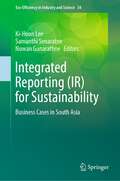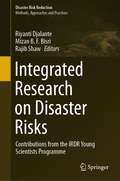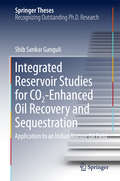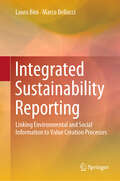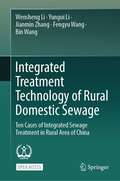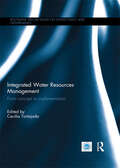- Table View
- List View
Integrated Protected Area Management
by ShaunRussell MikeWalkey Ian R. SwinglandProtected areas have become an increasingly important tool both in the conservation of biodiversity and in revenue generation through sustainable use. This is the only sure way to guarantee the protection necessary for many species, habitats and ecosystems in the future. Integrated Protected Area Management features contributions that consider the design, management and sustainable use of these regions. Three principal aspects are considered: the theory and practice of designation community-based conservation and the concept of sustainability identifying priorities for management. The emphasis throughout is on the importance of an interdisciplinary approach to planning and the active involvement of all stakeholders in decision-making processes as a means of ensuring long-term sustainability.
Integrated Regional Models: Interactions between Humans and their Environment
by Peter Groffman Gene E. LikensIntegrated regional models are conceptual and mathematical models that describe the physical environment, biological interactions, human decision-making, and human impact on the environment. Efforts are now being made to integrate regional models from the physical, biological and social sciences in order to respond to diverse environmental problems. This volume explores the latest research developments on processes operating at a variety of scales, including regions, and how scientists can combine their efforts to develop models linking biological, physical, and human systems. Data requirements for successful integrated regional models are identified and discussed. Chapters also consider methodological questions, such as whether to integrate disciplinary approaches at the beginning or the end of the modelling process, and whether integrated regional models should focus on specific regions or specific problems. The information in this volume will enable the reader to view problems such as coastal zone management, atmospheric pollution, non-point source pollution, commodity production in forested areas, and urban expansion in a broad, conceptual context. Researchers and graduate students in ecology, biology, geography and geology will benefit from this innovative approach to contemporary environmental problems.
Integrated Reporting: Antecedents and Perspectives for Organizations and Stakeholders (CSR, Sustainability, Ethics & Governance)
by Samuel O. Idowu Mara Del BaldoThis book critically examines the implementation and adoption of integrated reporting (IR) in organizations and corporations. A relatively new area of policy and practice, IR has rapidly gained considerable prominence since the formation of the International Integrated Reporting Committee in 2010. The book analyzes the outcomes and benefits as well as the shortfalls of integrated reporting. It offers an introduction to the foundations of IR and a comprehensive overview of its use through a number of detailed case studies. Lastly, it discusses the outlook for further developments in sustainability accounting and reporting.
Integrated Reporting: Business Cases in South Asia (Eco-Efficiency in Industry and Science #34)
by Ki-Hoon Lee Samanthi Senaratne Nuwan GunarathneThe book presents a rich collection of research studies on the theory and practice of corporate integrated reporting (IR) in South Asia. South Asia is emerging to compete in the world marketplace and one of fast economically growing regions to contribute to the global economy. As the region’s economic development accelerates, balancing economic and environmental development appears as a key sustainability challenge for governments, investors, consumers, and local communities. Companies in South Asia region are therefore increasingly challenged to reduce their environmental impacts and to contribute to sustainable development. This book includes valuable contributions of advanced research, concepts, applications, developments and case studies on corporate IR and sustainability accounting in South Asia and the roles of different professional accounting bodies to strength corporate sustainability and build capacity in the South Asian Region.
Integrated Reporting and Audit Quality: An Empirical Analysis in the European Setting (Contributions to Management Science)
by Chiara Demartini Sara TruccoThis book analyzes the relationship between integrated reporting and audit quality within the European context, presenting empirical evidence and drawing on a broad review of the available literature in order to evaluate the ability of integrated reporting to enhance audit risk assessment. Dedicated sections first elucidate the concepts of integrated reporting and audit quality. The main integrated reporting frameworks are compared, the role of integrated reporting within a firm’s disclosure is examined, and all aspects of audit risk are discussed. The key question of the impacts of integrated reporting on the components of audit risk is then addressed in detail, with reference to empirical findings, their practical implications, and their limitations. The concluding section explores the future of corporate reporting and the development of the next integrated reporting framework and summarizes the insights that the analysis in the book offers into the relationship between integrated reporting and audit quality in the European setting.
Integrated Research on Disaster Risks: Contributions from the IRDR Young Scientists Programme (Disaster Risk Reduction)
by Rajib Shaw Riyanti Djalante Mizan B. F. BisriThis book is a collection of works written by young scientists involved in the Integrated Disaster Risk Research (IRDR). Integrated Research on Disaster Risk (IRDR) is a decade-long research programme co-sponsored by the International Science Council (merged by International Council for Science (ICSU), the International Social Science Council (ISSC), and the United Nations Office for Disaster Risk Reduction (UNDRR). It is a global, multi-disciplinary approach to dealing with the challenges brought by natural disasters, mitigating their impacts, and improving related policy-making mechanisms. The book examines multidisciplinary research and actions related to disaster risk reduction internationally. The Integrated Research on Disaster Risk (IRDR) Young Scientists programme is: • A sub-programme within IRDR which promotes capacity building of young professionals and encourages them to undertake innovative and need-based research which makes science–policy and science–practice linkages stronger. • IRDR Young Scientists Programme was started in late 2016. Currently, it is a community of 115 young researchers from over 40 countries after 3 batches of application. • IRDR network and partners provide academic advice and training courses, workshops, and programmes for IRDR young scientists. • IRDR young scientists contribute to innovative research in the field of disaster risk reduction and participate in conferences and/or social media as the ambassador of IRDR. The book is of interest to researchers and scholars in the field of governance of sustainability and environmental governance. Postgraduate students will benefit this book within courses on environmental governance, on climate change governance, and on transformation and social change processes. Societal actors in climate change adaptation and other environmental governance fields on local, national, and international levels can benefit from the focus on societally relevant findings in the past 10 years of research on adaptiveness.
Integrated Reservoir Studies for CO2-Enhanced Oil Recovery and Sequestration: Application to an Indian Mature Oil Field (Springer Theses)
by Shib Sankar GanguliThis book addresses the feasibility of CO2-EOR and sequestration in a mature Indian oil field, pursuing for the first time a cross-disciplinary approach that combines the results from reservoir modeling and flow simulation, rock physics modeling, geomechanics, and time-lapse (4D) seismic monitoring study. The key findings presented indicate that the field under study holds great potential for enhanced oil recovery (EOR) and subsequent CO2 storage. Experts around the globe argue that storing CO2 by means of enhanced oil recovery (EOR) could support climate change mitigation by reducing the amount of CO2 emissions in the atmosphere by ca. 20%. CO2-EOR and sequestration is a cutting-edge and emerging field of research in India, and there is an urgent need to assess Indian hydrocarbon reservoirs for the feasibility of CO2-EOR and storage. Combining the fundamentals of the technique with concrete examples, the book is essential reading for all researchers, students and oil & gas professionals who want to fully understand CO2-EOR and its geologic sequestration process in mature oil fields.
Integrated Risk Governance: Science Plan and Case Studies of Large-scale Disasters (IHDP-Integrated Risk Governance Project Series)
by Peijun Shi, Carlo Jaeger and Qian Ye"Integrated Risk Governance: Science Plan and Case Studies of Large-scale Disasters" is the first book in the IHDP-Integrated Risk Governance Project Series. It consists of two parts: Part I: Integrated Risk Governance Project Science Plan, which outlines the challenge, research programme, outcomes, and implementation strategy of the IRG Project; and Part II: Case Studies of Large-scale Disasters, which includes case analyses of experience, lessons learned and recommendations on various large-scale disasters around the world, such as the Tangshan and Wenchuan earthquakes and the great ice storm in China, European heat waves, and Hurricane Katrina in the USA. The community model of integrated natural disaster risk governance and paradigm of catastrophe risk governance in China are also presented.Prof. Peijun Shi works at Beijing Normal University, China; Prof. Carlo Jaeger works at Potsdam Institute for Climate Impact Research, Germany; Prof.Qian Ye works at Beijing Normal University, China.
Integrated River Basin Management: Practice Guideline for the IO Table Compilation and CGE Modeling (SpringerBriefs in Environmental Science)
by Xiangzheng Deng Yi Wang Feng Wu Tao Zhang Zhihui LiEstablishing multi-scale optimal water allocation modes which takes the enhancement of utilization efficiency as core is a research hotspot for the international water resources management of river basins. This book aims to introduce how to compile the first set of county-level IO tables involving resources and environment accounts with integrated datasets which contains the spatio-temporal data of water and land resources, ecology and social economy in the river basin and to construct an integrated Computable General Equilibrium (CGE) model with resources and environment accounts embedded, which can be used to quantitatively depict the key process parameters of the water-ecology-social economy coupling system. Thus, this book can provide decision support for integrated river basin management, and scientific support for the sustainable development of social economy, eco-environment and water resources.
Integrated River Basin Management through Decentralization
by Karin Kemper William Blomquist Ariel DinarDrawing upon a worldwide survey of river basin organizations and in-depth studies of eight river basins in a variety of locations around the globe, this book examines how institutional arrangements for managing water resources at the river-basin level have been designed and implemented, the impetus for these arrangements, and what institutional features appear to be associated with greater or lesser success in river basin management.
Integrated Seismic Design of Structure and Control Systems (Springer Tracts in Mechanical Engineering)
by Paolo CastaldoThe structural optimization procedure presented in this book makes it possible to achieve seismic protection through integrated structural/control system design. In particular, it is explained how slender structural systems with a high seismic performance can be achieved through inclusion of viscous and viscoelastic dampers as an integral part of the system. Readers are provided with essential introductory information on passive structural control and passive energy dissipation systems. Dynamic analyses of both single and multiple degree of freedom systems are performed in order to verify the achievement of pre-assigned performance targets, and it is explained how the optimal integrated design methodology, also relevant to retrofitting of existing buildings, should be applied. The book illustrates how structural control research is opening up new possibilities in structural forms and configurations without compromising structural performance.
Integrated Soil and Sediment Research: Selected Proceedings of the First European Conference on Integrated Research for Soil and Sediment Protection and Remediation (EUROSOL) (Soil & Environment #1)
by TimoHamers Herman J. P.EijsackersIncreasing awareness of the irreversible and long-lasting impacts of deterioration and pollution of soils and sediments has had an important influence on environmental policies and research in the last decade. The complexity of the soil and sediment systems and its processes cannot be tackled properly unless scientists from different disciplines work together. With this in mind, a number of multidisciplinary soil research programmes have been started in various European countries. They involve different disciplinary approaches and they aim at different fields of application: agriculture, land use and town and country planning, drinking water supply, nature management. The results that are now appearing need to be integrated in a scientifically sound and useful way. The first European Conference on Integrated Research for Soil and Sediment Protection and Remediation was intended to foster this. The volume contains the edited and selected proceedings of this Conference.
Integrated Spatial and Transport Infrastructure Development: The Case of the European North-South Corridor Rotterdam-Genoa (Contributions to Economics)
by Hansjörg Drewello Bernd SchollThe challenge of growth in transport, especially in freight transport, and scarce resources in money, landscape and local opposition against new infrastructure investment require new solutions from transport policy. This book deals with these issues taking as an example the transport corridor Rotterdam-Genoa, one of the most heavily used in Europe. In 2010 the INTERREG project Code24 with partners from five European countries started with the aim to develop a transnational strategy to strengthen and to develop the corridor. The main objective was to accelerate and jointly develop the transport capacity of the entire corridor by ensuring optimal economic benefits and spatial integration while reducing negative impacts on the environment at local and regional level. These issues are highlighted in the book from an interdisciplinary perspective, taking into account spatial, economic, environmental and political aspects.
Integrated Stratigraphy of the Oxfordian and Kimmeridgian (Denkschriften der schweizerischen Naturforschenden Gesellschaft #104)
by Reinhart A. GygiIntegrated Sustainability Reporting: Linking Environmental and Social Information to Value Creation Processes
by Laura Bini Marco BellucciThis book proposes an integrated approach to sustainability reporting, the goal being to overcome certain limitations of the well-established additive approach, where the reporting of environmental, social and economic issues is sequential, but separate. It argues that, in order to successfully communicate its commitment to sustainability, a company should report on how environmental and social issues impact its way of doing business, namely its business model, contributing to value creation. Thus, a reporting framework for business models that encompasses sustainability is presented. In turn, a number of illustrative examples are examined to show how business model reporting could be optimally used to provide effective and integrated sustainability reporting. The book also offers a broad analysis of corporate sustainability reporting, which includes a discussion of the theoretical background, an explanation of why companies provide sustainability reporting, a description of the current regulatory framework for sustainability disclosure, and a review of sustainability reporting literature that shows the main characteristics of sustainability disclosure practices. Given its scope, the book will be of interest to all researchers and practitioners working for companies or organizations that aim to support, implement and improve their sustainability reporting, by adopting a more integrated approach that interconnects environmental and social aspects with the economic and financial results via the business model. The book also offers a valuable reference guide for social science researchers, including PhD students, interested in a discussion of the latest literature on sustainability, corporate social responsibility, and the communication of business models.
Integrated Sustainable Design of Buildings
by Paul ApplebyIntegrated Sustainable Design of Buildings aims to provide a guide to members of design and masterplanning teams on how to deliver sustainable development and buildings cost effectively, meeting current and emerging UK and international statutory and planning requirements. Using a series of case histories and examples from the author's ten years of providing sustainability advisory services the book sets out a clear and understandable strategy that deals with all aspects of sustainable design and construction and the implications for delivery, costs, saleability and long term operation. The extensive scope includes all aspects of environmental, social and economic sustainability, including strategies to reduce carbon emissions and the impact of climate change. Integrated Sustainable Design of Buildings appeared in the Cambridge Top 40 Sustainability Books of 2010.
Integrated Sustainable Design of Buildings
by Paul ApplebyIntegrated Sustainable Design of Buildings aims to provide a guide to members of design and masterplanning teams on how to deliver sustainable development and buildings cost effectively, meeting current and emerging UK and international statutory and planning requirements. Using a series of case histories and examples from the author's ten years of providing sustainability advisory services the book sets out a clear and understandable strategy that deals with all aspects of sustainable design and construction and the implications for delivery, costs, saleability and long term operation. The extensive scope includes all aspects of environmental, social and economic sustainability, including strategies to reduce carbon emissions and the impact of climate change. Integrated Sustainable Design of Buildings appeared in the Cambridge Top 40 Sustainability Books of 2010.
Integrated Systems of Meso-Meteorological and Chemical Transport Models
by Alexander Baklanov, Mahura Alexander and Ranjeet SokhiThis book, as the outcome of the COST-728/NetFAM workshop, focuses on the following main topics: 1) on-line coupled meteorology-chemistry modelling with two-way feedbacks, 2) off-line coupled modelling and interfaces, 3) validation and case studies including air quality related episodes, and 4) integration of atmospheric chemical transport (ACT) models with numerical weather prediction (NWP).This book is one of the first attempts to give an overall look on such integrated meso-meteorology and chemistry modelling approach. It reviews the current situation with the on-line and off-line coupling of mesoscale meteorological and ACT models worldwide as well as discusses advantages and shortcomings, best practices, and gives recommendations for on-line and off-line coupling of NWP and ACT models, implementation strategy for different feedback mechanisms, direct and indirect effects of aerosols and advanced interfaces between both types of models. The book is oriented towards numerical weather prediction and air quality modelling communities.
Integrated Technologies for Environmental Monitoring and Information Production (NATO Science Series: IV: #23)
by Nilgun B. Harmancioglu Sevinc D. Ozkul Okan Fistikoglu Paul GeerdersThis book presents the proceedings and the outcomes of the NATO Advanced Research Workshop (ARW) on Integrated Technologies for Environmental Monitoring and Information Production, which was held in Marmaris, Turkey, between September 10- 14, 200 I. With the contribution of 45 experts from 20 different countries, the ARW has provided the opportunity to resolve the basic conflicts that tend to arise between different disciplines associated with environmental data management and to promote understanding between experts on an international and multidisciplinary basis. The prevailing universal problem in environmental data management (EDM) systems is the significant incoherence between data collection procedures and the retrieval of information required by the users. This indicates the presence of problems still encountered in the realization of; (1) delineation of objectives, constraints, institutional aspects of EDM; (2) design of data collection networks; (3) statistical sampling; (4) physical sampling and presentation of data; (5) data processing and environmental databases; (6) reliability of data; (7) data analysis and transfer of data into information; and (8) data accessibility and data exchange at local, regional and global scales. Further problems stem from the lack of coherence between different disciplines involved in EDM, lack of coordination between responsible agencies on a country basis, and lack of coordination on an international level regarding the basic problems and relevant solutions that should be sought.
Integrated Treatment Technology of Rural Domestic Sewage: Ten Cases of Integrated Sewage Treatment in Rural Area of China
by Wensheng Li Yungui Li Jianmin Zhang Fengyu Wang Bin WangThis open access book provides integrated treatment technology of rural domestic sewage, and highlights ten typical cases in China. The integrated sewage treatment system (ISTE) combine sewage pretreatment, biological treatment, sedimentation, and disinfection, which particularly suitable for decentralized domestic wastewater treatment in rural areas without pipe networks. The main advantages of ISTE include the compact structure, small footprint, short construction period, high treatment efficiency, and economical rationality. First applied in Japan, ISTE has recently achieved rapid growth in China in the last decade. The relevant technological R&D, practice, and promotion experience accumulated by Chinese enterprises can offer significant reference to other developing countries and regions.The book consists of five chapters. The first chapter introduces characteristics, environmental risks and management styles of rural domestic sewage. The second chapter illustrates the collection and treatment approaches for rural domestic sewage.The third chapter presents the integrated sewage treatment process of high efficiency. The fourth chapter involves the design concept, manufacturing requirements, automatic control, and the cloud management system for ISTE. Chapter five covers ten typical application cases of ISTE in multiple regions of China. This book is suitable for graduate students, engineers, university teachers and government administrators engaged in decentralized sewage treatment.
Integrated Water Resource Management: An Interdisciplinary Approach
by Neil S. GriggThis book addresses the enormous global challenge of providing balanced and sustainable solutions to urgent water problems. The author explores our dependence on access to safe water and other water-related services and how driving forces of the human and natural worlds are degrading this access. The greatest challenges involve conflicts between people and interest groups across all countries, as well as the economic and political difficulties in finding solutions through infrastructure development. The book takes an interdisciplinary approach to Integrated Water Resources Management or IWRM, which provides a set of tools for policy development, planning and organization, assessment, systems analysis, finance, and regulation. The author suggests that IWRM is challenging because of the human element, but that no other process can reconcile the conflicting agendas involved with water management. The broad range of topics covered here, as well as 25 case summaries, will be of interest to scientists, engineers, practitioners, and advanced level students interested in the integrated management of water as a resource.
Integrated Water Resource Management: Cases from Africa, Asia, Australia, Latin America and USA
by Edson De Vieira Samuel Sandoval-Solis Valmir De Pedrosa J. Pablo Ortiz-PartidaThis book presents case studies that share important experiences regarding Integrated Water Resource Management (IWRM) in various countries. Following an introduction to theoretical concepts, responsibilities, and challenges, the subsequent chapters address, among other topics, an analysis of policies and regulations for water management in Brazil, the drivers that led California to adapt to the IWRM framework, and the international regulations for water markets and water banking in Australia and Chile. The implications of climate change for water resource systems in Mexico are discussed, as well as management strategies from California that could potentially serve as IWRM adaptation schemes in Mexico. Critical cases from Guanacaste (Costa Rica), and from Zayandehrud River Basin and Lake Urmia (Iran) are reviewed in terms of management practices and solutions. The book also provides an overview of the current availability and use of water resources in South Korea, and discusses the management of and international water law instruments for transboundary groundwater in Africa.
Integrated Water Resources Management: From concept to implementation (Routledge Special Issues on Water Policy and Governance)
by Cecilia TortajadaThe book includes seventeen excellent researched and documented papers that reflect the diversity of thought, ideas and experiences related to IWRM. They draw from an extensive, inclusive and geographically representative range of theoretical propositions and practical examples. These include the implementation status of the IWRM concept at local, basin, regional and national levels; its appropriateness for the twenty-first century; main implementation gaps from the institutional, legal, policy, governance, management and technical viewpoints; the likelihood that IWRM’s entrenchment in laws, regulations and policies has led to smoother implementation and the reasons why that has been the case; reflexions on whether the attention given to IWRM is pushing other alternatives to the policy periphery; and the new conceptual constructions that can be put forward for discussion in the international arena.For the development and water communities it is imperative to debate and reach towards more illustrative conclusions regarding whether the promotion of the IWRM concept and its actual implementation status have been beneficial for development and how the notion could evolve to achieve this end. In-depth objective and constructive discussions, arguments, proposals and ideas are put forward for analysis by all interested parties. The book has the objective of fostering scholarly exchange, encouraging intellectual debate and promoting the advancement of knowledge and understanding of IWRM as a concept, as a goal per se and as a strategy towards development goals.This book was published as a special issue of the International Journal of Water Resources Development.
Integrated Water Resources Management: From concept to implementation (Routledge Special Issues on Water Policy and Governance)
by Cecilia TortajadaThe book includes seventeen excellent researched and documented papers that reflect the diversity of thought, ideas and experiences related to IWRM. They draw from an extensive, inclusive and geographically representative range of theoretical propositions and practical examples. These include the implementation status of the IWRM concept at local, basin, regional and national levels; its appropriateness for the twenty-first century; main implementation gaps from the institutional, legal, policy, governance, management and technical viewpoints; the likelihood that IWRM’s entrenchment in laws, regulations and policies has led to smoother implementation and the reasons why that has been the case; reflexions on whether the attention given to IWRM is pushing other alternatives to the policy periphery; and the new conceptual constructions that can be put forward for discussion in the international arena.For the development and water communities it is imperative to debate and reach towards more illustrative conclusions regarding whether the promotion of the IWRM concept and its actual implementation status have been beneficial for development and how the notion could evolve to achieve this end. In-depth objective and constructive discussions, arguments, proposals and ideas are put forward for analysis by all interested parties. The book has the objective of fostering scholarly exchange, encouraging intellectual debate and promoting the advancement of knowledge and understanding of IWRM as a concept, as a goal per se and as a strategy towards development goals.This book was published as a special issue of the International Journal of Water Resources Development.
Integrated Water Resources Management and Security in the Middle East (NATO Science for Peace and Security Series C: Environmental Security)
by Clive Lipchin Eric Pallant Danielle Saranga Allyson AmsterThis volume brings together diverse voices relating to the critical issue of water management in one of the world’s most politically volatile areas: the Middle East. The book collects the opinions of Palestinians, Israelis, Jordanians as well as international experts on creating a holistic and comprehensive view of water management challenges and strategies in the Middle East.



